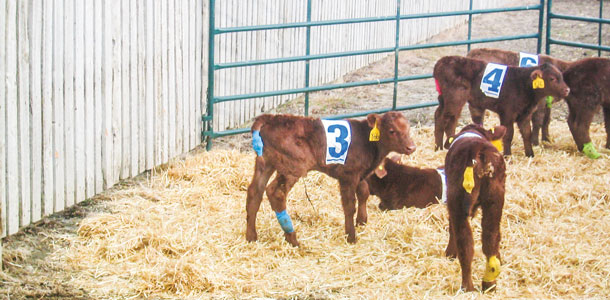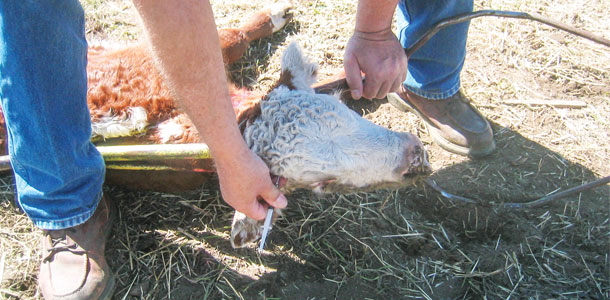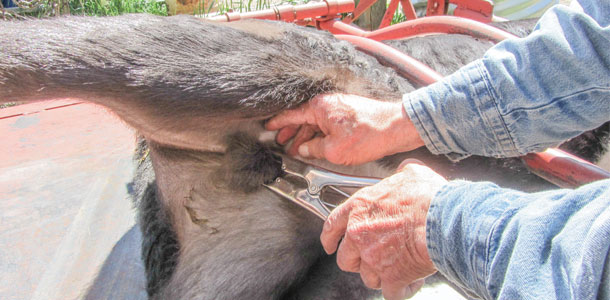One issue that still needs to be addressed is pain management when doing routine procedures such as branding, castrating and dehorning.
Dr. Eugene Janzen from the University of Calgary says the veterinary profession looking after food animal production in Canada is in the midst of rapid change.
“If a veterinarian in Alberta castrates a cat or a horse without using anesthetic and pain mitigation, that veterinarian would be at risk of losing his or her license. Yet if we are castrating a calf or bull, no one would notice,” he says. The same is true in the U.S.
The cattle industry in North America is still evolving from centuries-long traditions of having to do routine surgical tasks without the means for pain suppression.
Cattle were roped and branded, castrated and dehorned out on the range or in the corral. We’ve streamlined and adjusted some of the ways we handle cattle so it’s easier on them, but we are still not addressing the pain issue.
There will be increasing pressure on the livestock industry to use more humane methods. We need to find a way to deal with pain in farm animals because these surgical procedures are a necessary part of animal husbandry.
Studies on pain management
Janzen was involved with several studies on pain, comparing castration methods using pain mitigation versus no pain management.

He and a group of colleagues began these studies a few years ago because of the disparity between practices for food animals and other animals.
“We recognize that we will be scrutinized by society if we don’t manage pain, but our farm animals also deserve to have their pain mitigated just like companion animals,” he says.
“One of the things that concerned me some years back was having to castrate mature bulls in a feedyard, so in our first studies we used an epidural anesthesia when castrating bulls, and it worked very well."
"The main drawback was that it had to be given 20 minutes before the surgery. One of the big issues with pain medication is that the animal has to have it onboard before you initiate a painful procedure.”
For instance, when the dentist blocks your jaw, he does not immediately began to drill.
It doesn’t matter which pain mitigation method you plan to use; it has to be given a certain length of time ahead of the painful procedure.
“There are many injectable products, and we looked at three: ketoprofen, flunixen and meloxicam. We have some of them available in Canada in our food animals, yet my colleagues in the U.S. tell me they don’t have anything labeled for pain mitigation in food animals,” says Janzen.
Injectable drugs are given subcutaneously and need 20 to 30 minutes before a procedure. They will not eliminate pain completely.

“To do that, you’d need anesthesia, like you’d get with an epidural,” Janzen said. “ For dehorning, you could use a cornual nerve block for pain elimination."
"I have been at brandings and blocked the horns for pain elimination, and asked the cowboys to leave the animals lying there for three minutes before we burn the horns off – to give it time to be effective.”
“For a couple years I have used meloxicam for pain on a certain ranch, and last year we medicated a subset of calves three hours ahead of time."
"The ropers who dragged the calves to the fire could tell there was a big difference. The calves did not vocalize and didn’t struggle as much. They were almost sedated. ”
Efforts toward using pain medication in the U.S.
Dr. Jessica Laurin, a veterinarian with a mixed practice in Marion, Kansas (Animal Health Center of Marion County) says that an international symposium for beef cattle welfare was started several years ago.
“This symposium addresses various topics that veterinarians and producers face. The fourth annual symposium was held July 16-18, 2014 at Iowa State University."

"One of the speakers was Dee Griffin, discussing dehorning and castration, and ways that veterinarians and producers can work together to address and mitigate pain in cattle when doing these procedures,” she says.
“The drugs available in the U.S. for pain relief in animals are not over-the-counter products for producers to have in their hands. So producers need to work with their veterinarians."
"Groups like the National Cattlemen’s Beef Association, the American Association of Bovine Practitioners and the Academy of Veterinary Consultants can help with veterinarian education so they can work with producers. Any products that come on the market in the future will be prescription-labeled – addressed by the FDA,” she says.
“Iowa State University, Great Plains Veterinary Education Center and others are trying to assist us with tools we as veterinarians can use. Each producer-veterinarian scenario will be different."
"In some situations, the drugs will be best in the hands of the veterinarian because the vet will be doing more castrations/dehorning than producers. In other situations, some producers who do it more frequently, with more volume of cattle, can be taught by the veterinarian how to use these pain mitigation tools,” Laurin explains.

Dr. Renee Dewell at Iowa State University put together two instructional videos after the symposium. One shows how to do lidocaine blocks while doing castrations, and the other shows how to do lidocaine blocks when dehorning.
“Pain management can be practical and fit into many standard beef cattle production scenarios,” says Dewell. “The use of local anesthetic for castration may actually increase the speed that cattle can be worked, particularly for producers that use chutes or when doing larger calves."
"The producer can use automatic syringes attached to tubing, with a lidocaine bottle, and set the dose appropriate for the largest calf in that group. Administration of a lidocaine block only takes a few seconds and can greatly decrease the stress on both the calf and the caregivers,” she explains.
“This type of pain mitigation takes away or greatly decreases the ‘fight’ in the animal and the bawling sometimes associated with painful procedures such as castration or branding. It may also make it safer for the person performing the procedures because the calf is less likely to struggle or will struggle less vigorously.”
Techniques for blocking pain prior to castration or dehorning are not difficult to learn, are not expensive to administer and do not require much time to administer. “They work almost immediately and provide short-term relief to the animal for procedures like castration and dehorning,” says Dewell.
“Longer-term relief can be achieved through the use of non-steroidal anti-inflammatory (NSAID) drugs such as meloxicam. Costing only pennies per hundredweight, meloxicam can be administered orally, begin to take effect within about 30 minutes and last several hours. The withdrawal time is approximately 21 days,” she says.
This is easy to comply with because producers will not be selling or butchering an animal that soon after dehorning or castration.
“The use of meloxicam as an analgesic is considered extra-label use by the Animal Medicinal Drug Use Clarification Act (AMDUCA)."
"However, the FDA Center for Veterinary Medicine has clarified that analgesics such as meloxicam and anesthetics such as lidocaine are acceptable to use for the purpose of alleviating pain."
"It should be emphasized that when producers use these drugs, they should always be used in the context of a veterinarian-client-patient relationship, following AMDUCA guidelines,” Dewell says. ![]()
Note: Prior to the enactment of AMDUCA, extra-label drug use in animals was always illegal.
AMDUCA amended the Federal Food Drug and Cosmetic Act to legalize extra-label use under a valid veterinarian-client-patient relationship to give veterinarians more flexibility to treat their patients – since there are relatively few animal drugs available.
Heather Thomas is a freelance writer based in Idaho.
PHOTO 1: Calves painted red are the untreated control group for one pain management study. Photo courtesy of Heather Thomas.
PHOTO 2: Calves in this study were labeled with large stick-on numbers for the video camera that recorded behavior after processing. Photo courtesy of Heather Thomas.
PHOTO 3: Giving a nerve block on both sides of the head before any other procedures begin, so the calf won’t feel pain when dehorned. Photos courtesy of Dr. Eugene Janzen.
PHOTO 4: Dehorning is a painful procedure unless the calf receives pain medication. Photo courtesy of Heather Thomas.
PHOTO 5: Banding a calf is not very painful at the time it is done, but there is pain later. Photo courtesy of Heather Thomas.









